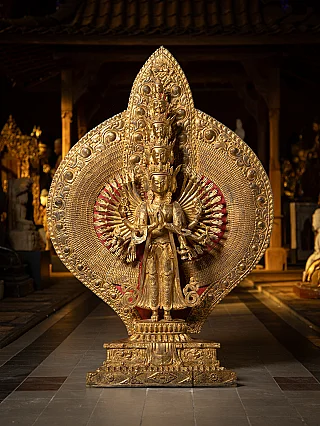Chinese Buddhism
Author : Peter Vredeveld

Chinese Buddhism is one of the oldest Buddhism in Buddhist History. Chinese Buddhism practice Mahayana Buddhism widely and is believed to be the combination of Buddhism and Taoism. There may be hundred of millions of people who believed in Chinese Buddhis
Buddhism is one of the oldest foreign religions in China. There is a strong, prominent, and dynamic influence of Chinese Buddhism in the history of Chinese Buddhism. Mahayana Buddhism is one of the widely used aspects of Buddhism in China. The history of Buddhist tradition in China is believed to go back thousands to two thousand years. Over time, China has experienced a wide range of culture, art, politics, and material culture. Chinese Buddhism is believed to be a combination of Taoism and Buddhism. There may be millions or more people who believe in Chinese Buddhism.
Origins
It is believed that Buddhism arrived in China nearly 2000 years ago, although various legends exist about the presence of Buddhism in very ancient times. Buddhism is believed to have arrived in China during the rule of the Han Dynasty. During the Han Dynasty, most people intensely followed the Confucian religion, but those who followed the Taoist religion existed. Before the rule of the Han dynasty, Buddhism had already spread through major Central Asian countries with the campaign set up by Emperor Asoka the Great in the 3rd Century B.C. Asoka sent missionaries throughout central Asia to spread Buddhism and the worthiness of Lord Buddha. Due to this campaign, Buddhism became Pakistan and Afghanistan's main religion and the center of Buddhist teachings, learning, and practices.
When the Han Dynasty expanded its empire to Central Asia, trade and cultural traditions flourished between China and Central Asia. Due to this involvement, Chinese people learned about Buddhism from the missionaries in the 1st Century B.C. When Buddhism arrived in China, there was no friendly relation between Confucianism and Buddhism because Confucianism was about maintaining focus, harmony, and social order. In contrast, Buddhism was all about entering the monastic life and seeking reality beyond reality. However, Taoist principles were very similar to Buddhism's in many respects. That's why some Chinese followed Buddhism from the perspective of Taoism. Early Sanskrit Buddhist text that was translated into Chinese used Taoist terminology. From that period to now, Buddhism has played an essential role in Chinese history.
Major Schools

Four primary schools emerged in China when Mahayana Buddhism was at its peak in the country's Buddhist history. In 402 CE, the monk and teacher Hui-yuan established one of China's most famous Buddhist societies. This particular society was known as the White Lotus Society and was established in Mount Lushan in southeast China. The establishment of the White Lotus Society became the foundation for the beginning of the Pure Land School of Buddhism. It is one of the oldest and most popular schools in China. Currently, the Pure Land School of Buddhism is the dominant form of Buddhism in Japan.
Another school that emerged in China was the Ch'an School of Buddhism, one of the dominant forms of Buddhism in China and Japan. In 500 CE, an Indian Sage, Bodhidharma, arrived in China. The arrival of Bodhidharma became the foundation for the development of the Ch'an School of Buddhism. Bodhidharma established the Ch'an School at the Shaolin Monastery. It is also believed that Bodhi dharma fused Shaolin, practiced in China, and Buddhism to establish this school. The Ch'an School of Buddhism is known in the West by the Japanese name Zen.
Shortly after the Ch'an School of Buddhism was established by an Indian Sage, Bodhidharma, another distinctive Buddhist school emerged in the mid-fifth century. Zhiyi was a monk, and the Tiantai School of Buddhism was established under the influence of his teachings. Tiantai School of Buddhism was based on the primary principle of Lotus Sutra, and Tiantai's emphasis on Lotus Sutra influenced many other Buddhist schools to emerge. Another school of Buddhism emerged, and this school was called Huayanand, popularly also known as Kegon in Japan. Huayan School of Buddhism was established under the guidance of three patriarchs. The three patriarchs were Tu-shun, Chih-yen, and Fa-Tsang or Fazang. During the rule of the Tang Dynasty, a large part of the teachings of the Huayan School of Buddhism were absorbed into the Ch'an School of Buddhism.
Tang Dynasty
During the rule of the Tang Dynasty, Buddhism's influence peaked, especially in the era between 618 and 907 CE. The dominance of Buddhism was more significant in the Tang Dynasty than in any other dynasty or era. During Tang Dynasty, suppression of Buddhism began at the end of the Tang Dynasty. According to Buddhist history in China, around 4000 monasteries, 40,000 temples and shrines, and Buddha statues were destroyed in 845 CE. Only the Pure Land School of Buddhism and the Ch'an School of Buddhism survived this massive suppression. Tiantai School of Buddhism flourished in Japan, and the teachings of Huayan flourished in Japan instead, and the teachings of Huayan were visible in the Ch'an School due to this suppression.
Budai – Laughing Buddha
The beginning of the 10th century marked the end of a thousand years of typical Buddhism in China. The legend of Budai po, popularly known as Laughing Buddha, emerged in Chinese culture. Budai is depicted as the incarnation of Maitreya or the future Buddha. In the present time, Budai is one of the iconic figures of Chinese Buddhism and is quite popular in East Asia.
Share this page


















